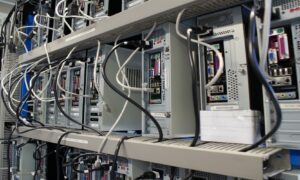Welcome to the future of datacenters! In a world where information is the new currency, traditional computing infrastructure simply can’t keep up with our insatiable demand for speed and efficiency. Enter hyperscale computing, the game-changer that’s revolutionizing data centers as we know them. Buckle up as we take you on an exhilarating journey through this technological powerhouse, unraveling its mind-boggling capabilities and exploring how it’s reshaping the very fabric of our digital landscape. Get ready to unleash the power of hyperscale computing like never before!
Introduction to Hyperscale Computing
As the world increasingly relies on digital technologies, the demand for faster, more efficient computing has never been higher. This is where hyperscale computing comes in. Hyperscale computing is a type of scalable architecture that can handle very large workloads. It is often used by companies that have large amounts of data to process, such as social media platforms and search engines.
Hyperscale computing is made possible by advances in computer hardware and software. One key element is the use of commodity hardware, which helps keep costs down. Another important factor is the use of open-source software, which allows for flexibility and customizability.
The benefits of hyperscale computing are many. It can provide organizations with the ability to process large amounts of data quickly and efficiently. It can also help improve service levels and create new opportunities for business innovation.
How Hyperscale Computing is Revolutionizing the Datacenter
The hyper-scale computing model is built on the concept of using commodity hardware and open-source software to create large, scalable systems. This approach has been pioneered by companies like Google and Facebook, which have used it to build some of the largest and most efficient data centers in the world.
Now, hyperscale computing is starting to revolutionize the data center industry as a whole. By making it possible to use commodity hardware and open-source software to build scalable data centers, hyper-scale computing is making it possible for organizations of all sizes to create highly efficient data centers that can meet their specific needs.
In addition, hyperscale computing is making it possible for data centers to be more flexible and responsive to changes in demand. By using commodity hardware and open-source software, datacenters can quickly add or remove capacity as needed without having to worry about compatibility issues.
Hyperscale computing is helping to drive down the cost of data center infrastructure. By using commodity hardware and open-source software, organizations can save money on upfront costs and ongoing maintenance expenses.
Challenges of Implementing Hyperscale Computing
As the world of data and technology continues to grow and evolve, so too must the way we process and store this information. This is where hyperscale computing comes in. Hyperscale computing is a term used to describe a new type of architecture that is designed to meet the demands of large-scale data processing and storage.
However, while hyperscale computing has many benefits, it also comes with its own set of challenges. One of the biggest challenges is ensuring that all components are properly scaled. This includes both hardware and software. Another challenge is managing power consumption. With so many components working together, it can be difficult to keep track of energy usage and ensure that it stays within acceptable levels.
Security is always a concern with any large-scale system. When dealing with hyperscale computing, businesses need to be extra vigilant about protecting their data from both external threats and internal breaches.
Hyperscale computing presents both opportunities and challenges for businesses looking to take advantage of its power. By understanding these challenges and taking steps to address them, businesses can reap the many benefits that hyper-scale computing has to offer.
The Future of Hyperscale Computing and Datacenters
The hyperscale computing revolution is upon us. The days of the small, isolated data center are numbered. In their place, we are seeing the rise of huge facilities that can house hundreds of thousands of servers.
This shift to hyper-scale data centers is being driven by several factors. First and foremost, there is a need for more computing power. As we move into an era of big data and artificial intelligence, the demand for processing power is only going to increase. Hyperscale data centers can cost-effectively provide this power.
Another factor driving the shift to hyperscale is the need for greater efficiency. Traditional data centers are often inefficient, with a lot of wasted space and energy. Hyperscale data centers are designed from the ground up to be efficient, making use of every square inch of space and using less energy per server than traditional data centers.
Hyperscale data centers offer greater flexibility and scalability than traditional data centers. They can be easily expanded or reconfigured to meet changing needs, making them ideal for companies that are growing quickly or whose needs fluctuate frequently.
The shift to hyperscale computing is inevitable. It’s already underway, and it’s only going to accelerate in the years to come. Datacenter operators who don’t make the switch will be left behind.
Conclusion
Hyperscale computing is revolutionizing data centers by providing the ability to scale resources quickly and efficiently. This technology reduces costs, increases performance, and creates a more reliable system for businesses of all sizes. It also offers the potential for new applications that can take advantage of these massive computing power clusters. By delving into hyperscale computing, organizations can unlock their potential to create faster and better services that will drive innovation in the world today.



































